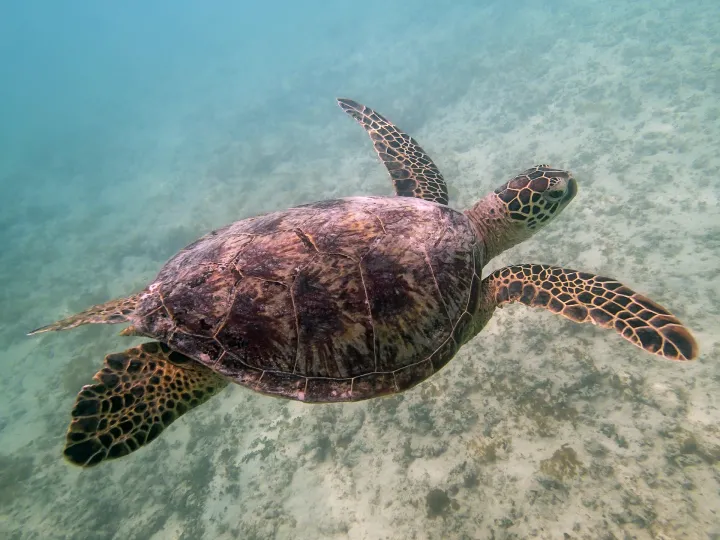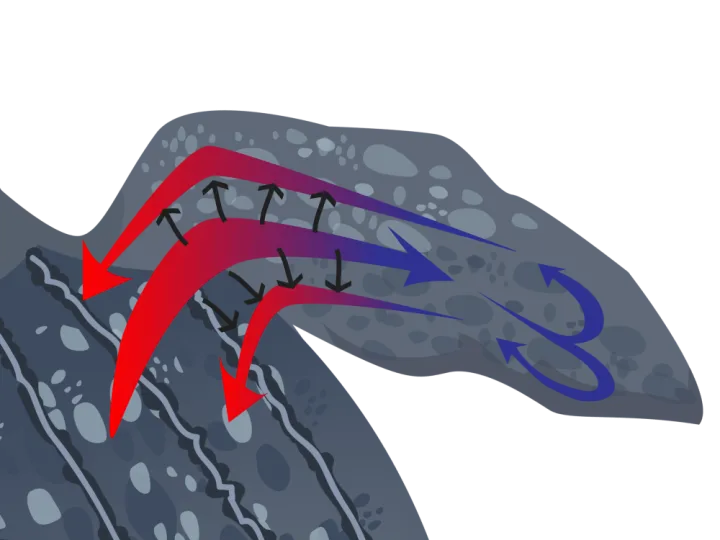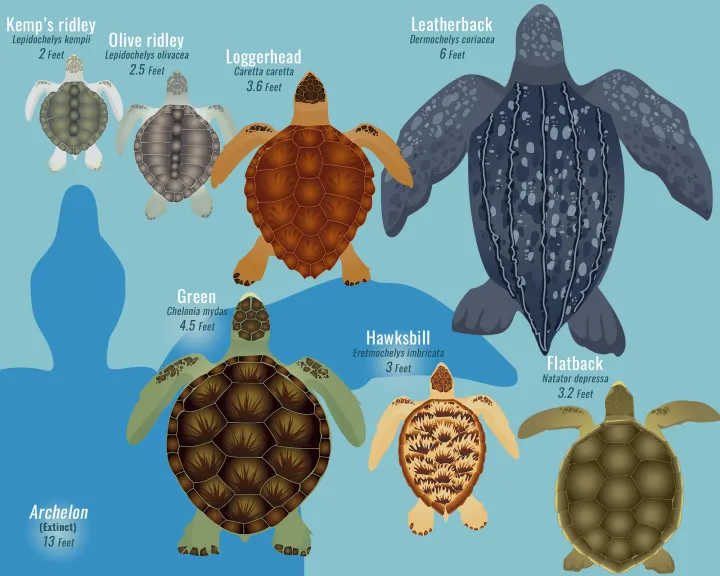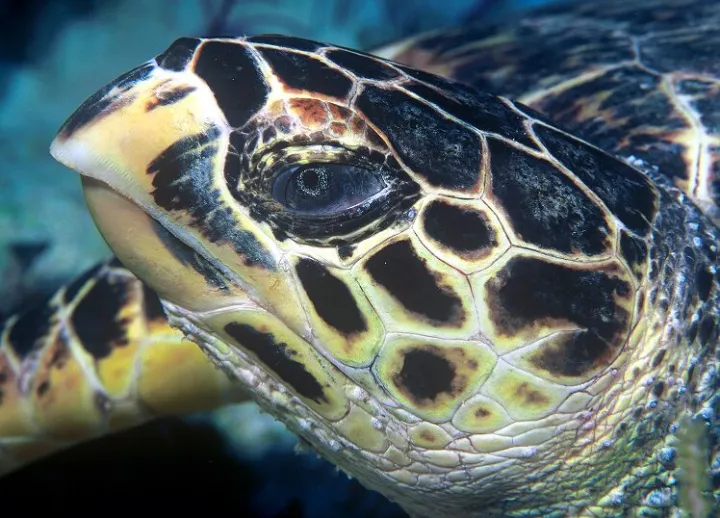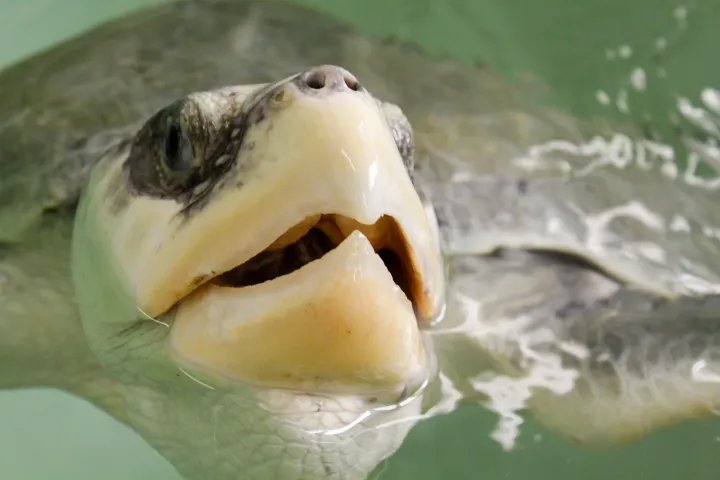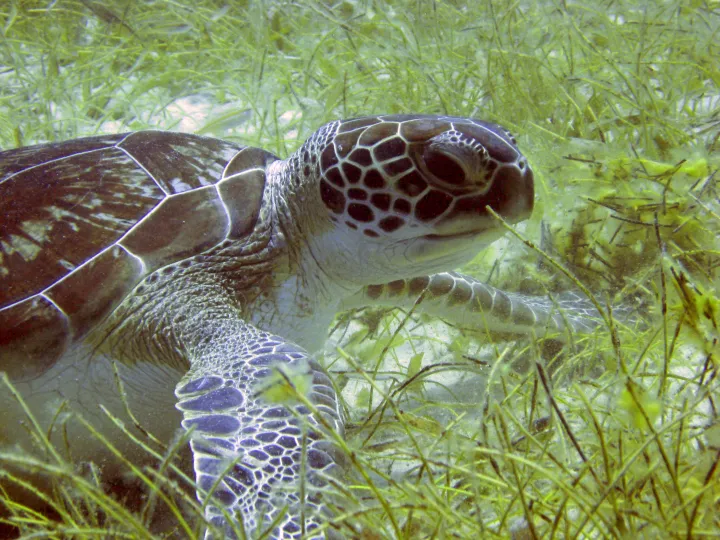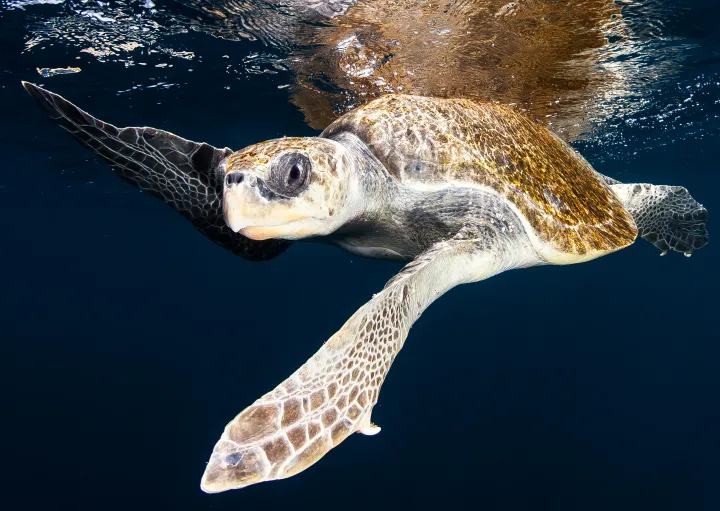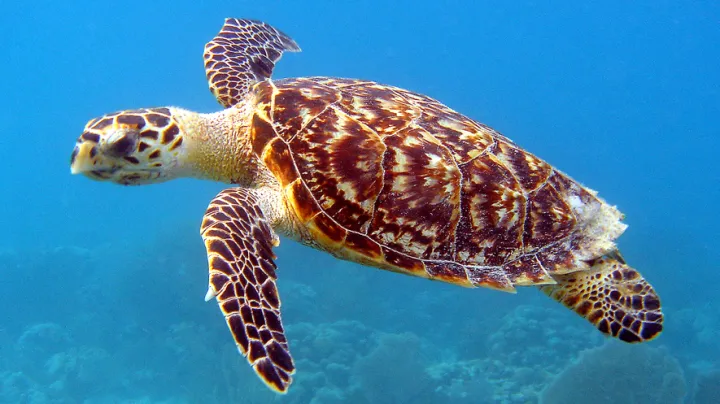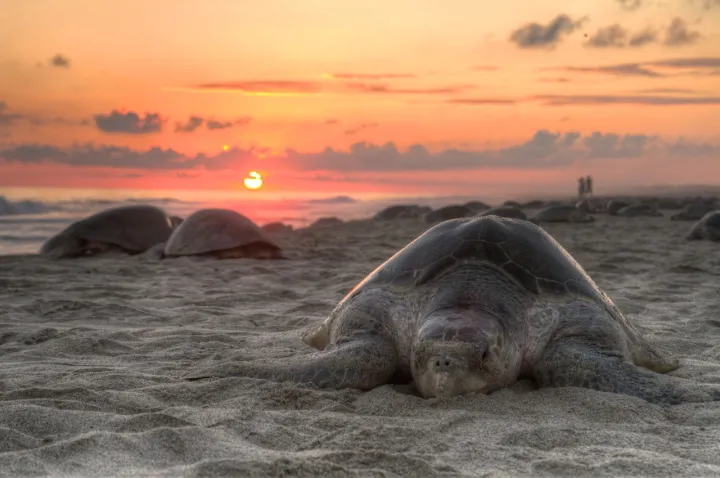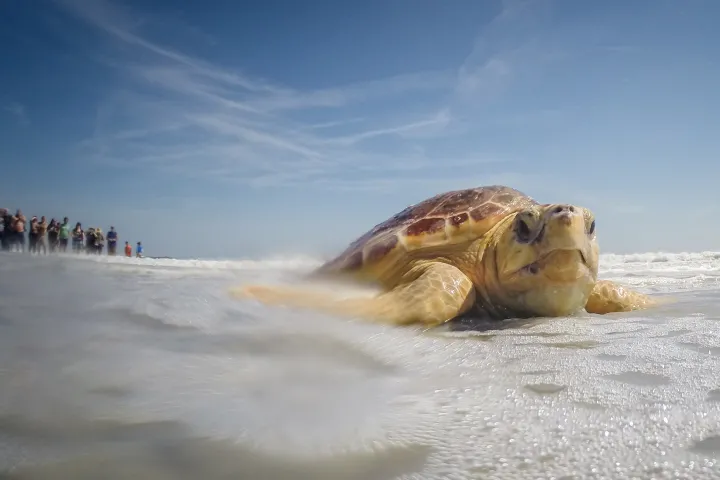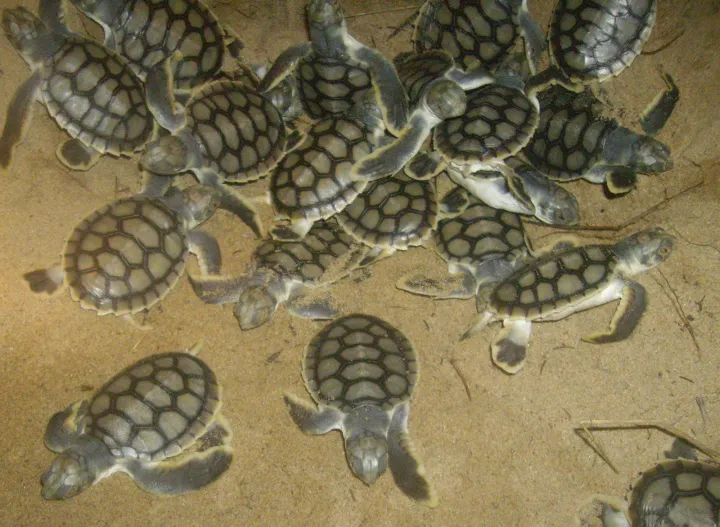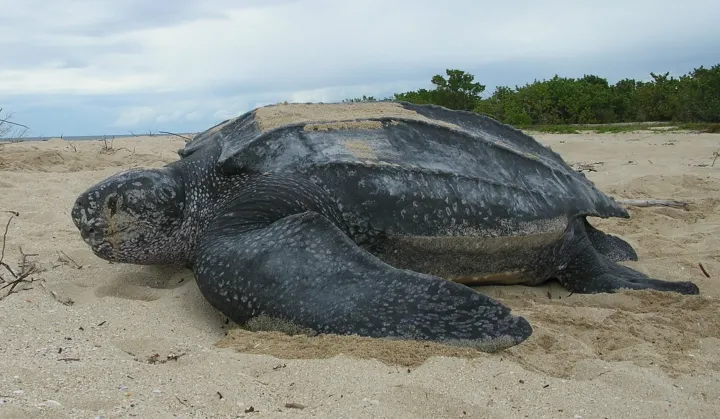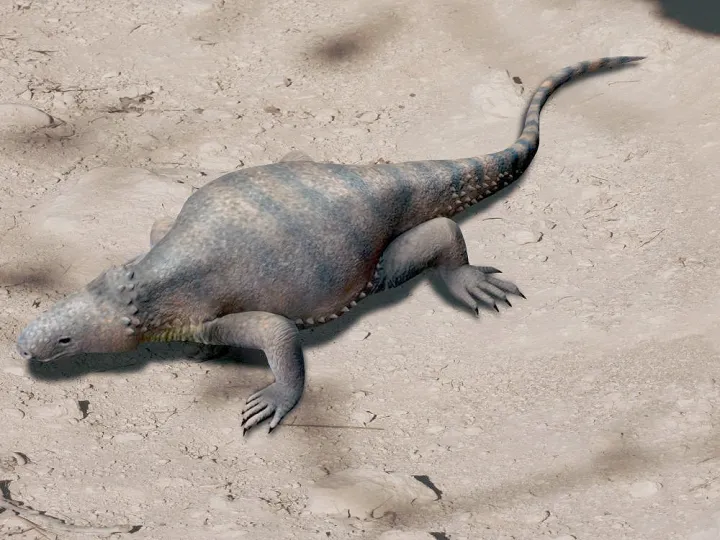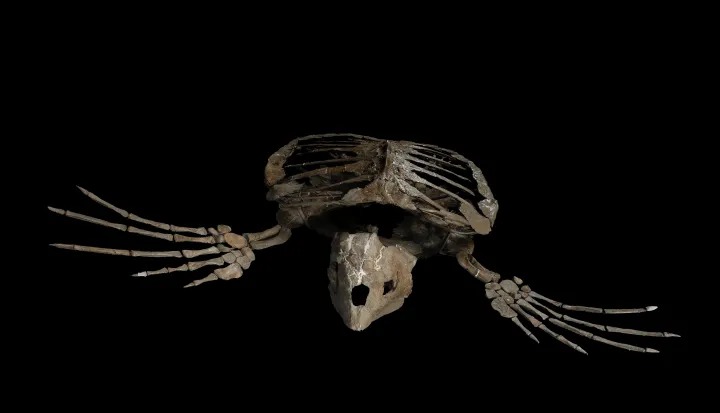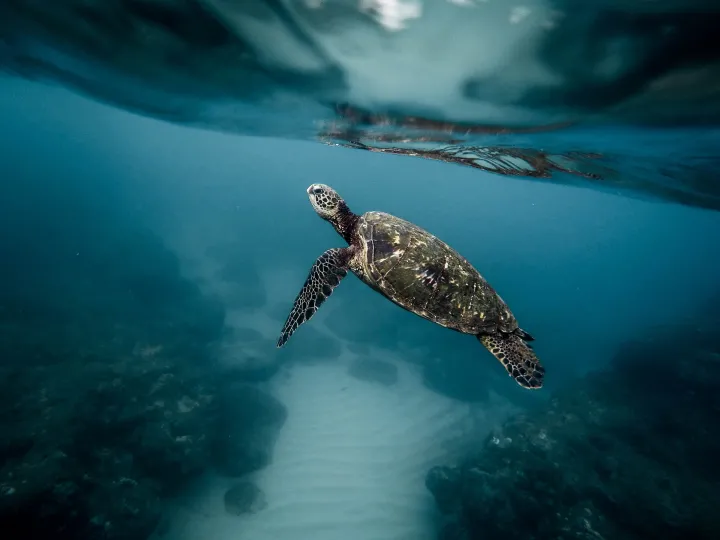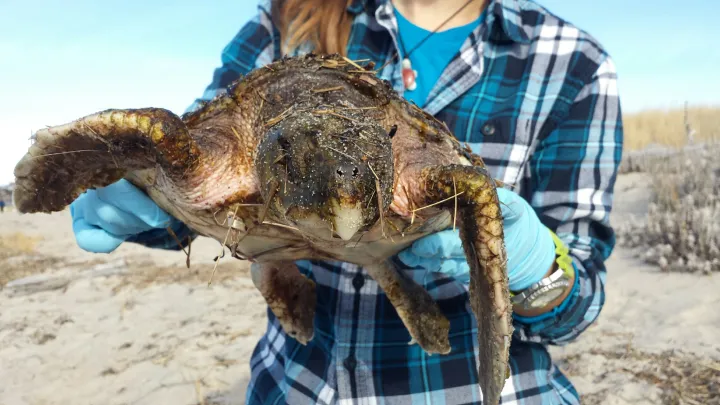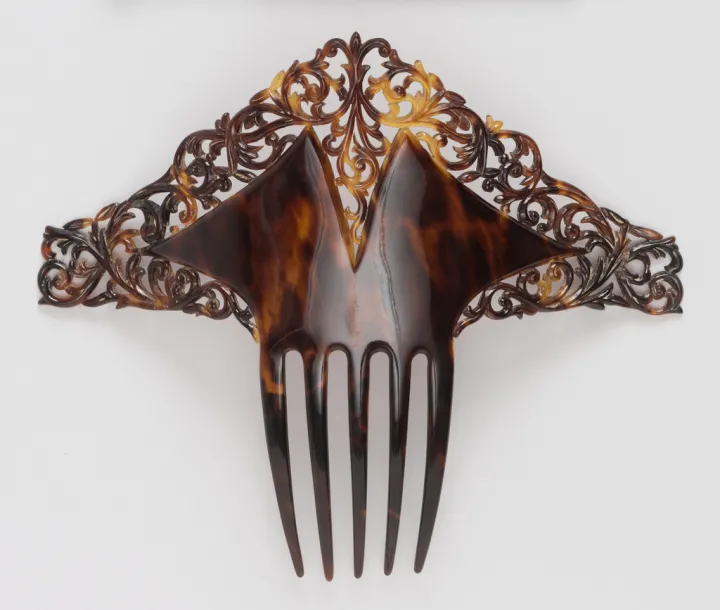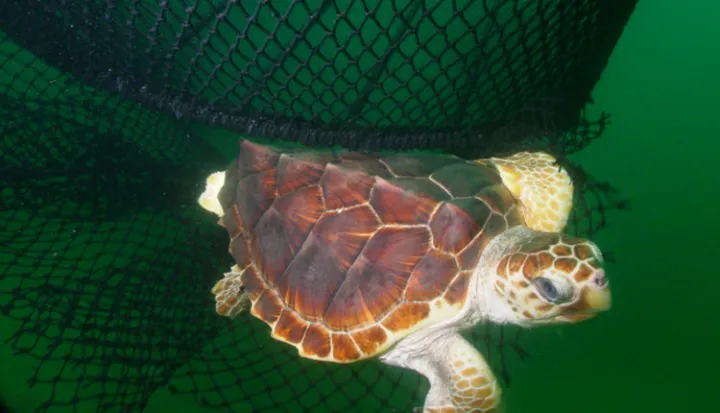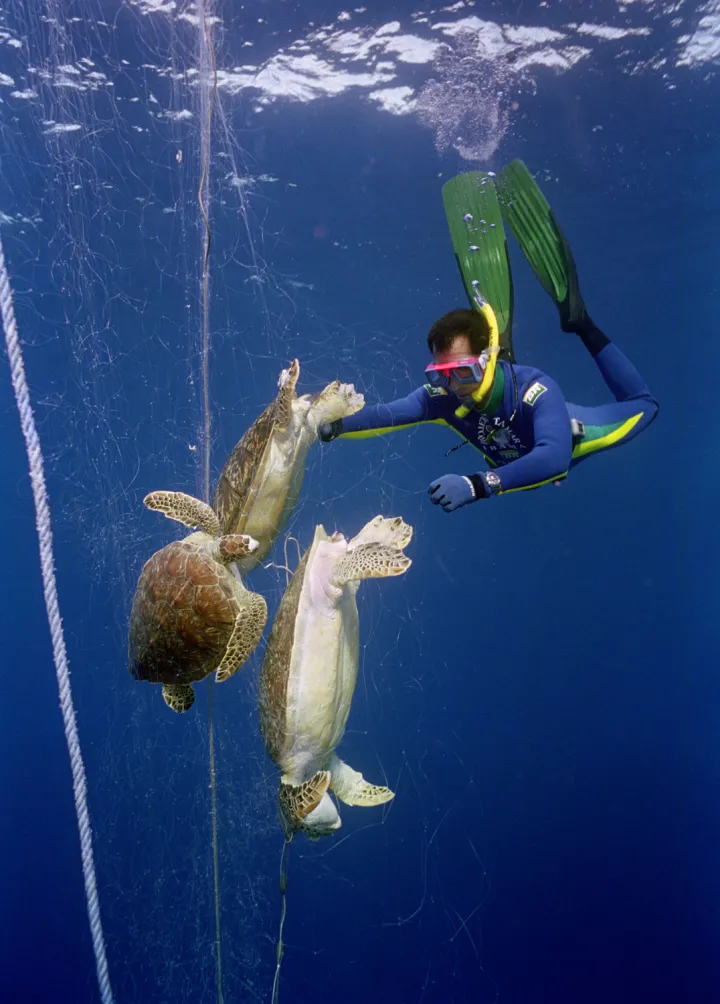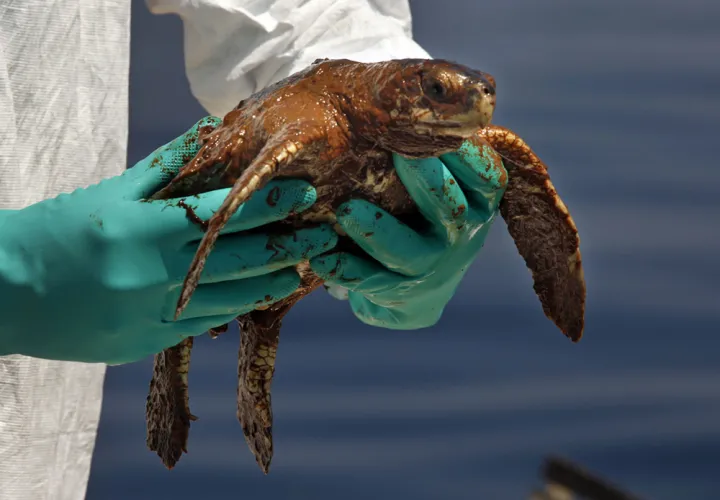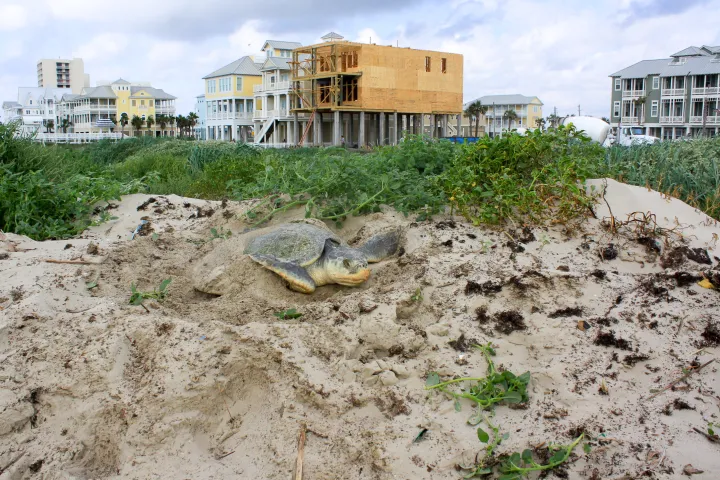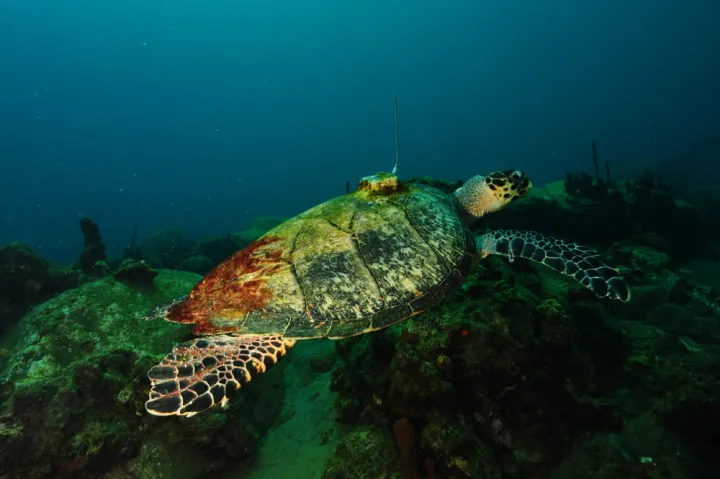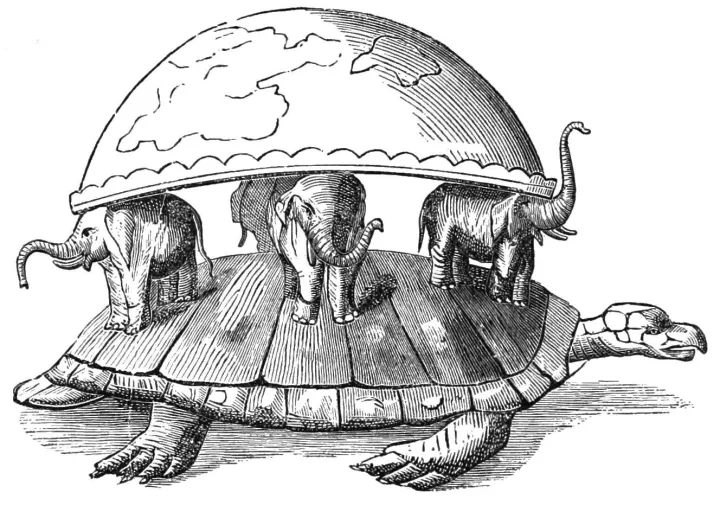
Sea Turtles
Introduction
Often considered the most majestic of the turtle family, the sea turtle is a large, ocean-going reptile known for its gentle nature and long lifespan. Swimmers, snorkelers and divers revel in seeing these stunning creatures glide by effortlessly through the sea. Though often associated with the tropics, sea turtles are actually found in all of the world’s oceans except for the polar seas. Sea turtles have been revered by humans for millennia. In fact, many creation stories in various world cultures feature tales of the world being built on the back of a sea turtle.
Today, there are seven species of sea turtles in existence, and most are listed as at least vulnerable to extinction under the IUCN’s Red List. These ancient reptiles, which have been around since the age of the dinosaurs, may yet disappear if we do not act to conserve them.
Are You An Educator?
Anatomy, Diversity & Evolution
Anatomy
Reptile of the Sea
Sea turtles are adapted to live in the ocean, with some unique features that help them to survive in the marine environment. As reptiles, they require air to breathe and land to lay their eggs. However, the majority of their lives are spent underwater.
Unlike their freshwater relatives, the head and limbs of sea turtles are fixed outside the shell and cannot retract into the shell. This distinctive feature, along with a streamlined shell, makes them more hydrodynamic in the water than their land-based counterparts, allowing them to maneuver easily through their saltwater habitat.
Sea turtles are generally not extremely fast swimmers. Usually, they cruise at around 0.9 to 5.8 mph (1.4 to 9.3 km/h), but have been found to swim up to 22 mph (35 km/hr) when frightened. To help them efficiently power their bodies through water, sea turtles have long flippers instead of the webbed feet of their freshwater counterparts. The large and strong front flippers act like paddles to propel them through the water, while the smaller back flippers function as rudders to help them steer. In females, the hind flippers have another purpose as well—they are used to dig an egg chamber in the sand when they come ashore to nest.
The seven sea turtle species are part of a group of about 100 living marine reptile species in the world. Living in salty ocean water is not easy and many marine organisms have special adaptations in order to survive in the excessive salt of their environment. If sea turtles had a salt concentration in their body the same as their seawater surroundings, it would be lethal. When eating, they ingest a large amount of salty seawater. To get rid of this excess salt, sea turtles have large glands by their eyes that release salt in higher concentrations than the surrounding ocean water. These salt glands are why many people who observe sea turtles on land believe that the animals are crying. The leatherback sea turtle has extremely large salt glands compared to other species; their glands are more than twice the size of their brains. They require such large salt glands because of their preferred diet of jellyfish. Since jellies are composed of mostly seawater, the leatherback ingests much more salt while feeding than any other sea turtle species.
Sea turtles cannot breathe underwater, but they can hold their breath for long periods of time—between 4 to 7 hours when resting. While holding their breath, their heart rate slows significantly to conserve oxygen—up to nine minutes can pass between heartbeats. Because of this, sea turtles can stay underwater for an extended period of time when not stressed.
Their breath-holding abilities allow them to dive deep in the ocean to find food. Most turtles can dive to depths of up to 290 m (960 ft). However, one species of sea turtle—the leatherback—can dive over 1,000 m (3,000 ft)! The maximum depth ever recorded for a sea turtle dive was a leatherback that dove 1,200 m (3937 ft). Leatherbacks are able to do this because of their adaptations for deep diving. Unlike the other species of sea turtles, leatherbacks have a flexible shell that absorbs nitrogen and collapsible lungs that allow them to compress themselves while diving to cope with the pressure change. The turtles have large stores of oxygen in their blood and muscles and a drastically slowed heart rate to conserve oxygen while diving.
Reptiles are ectothermic, meaning they rely on the environment to regulate their body temperature, and sea turtles are no exception. It is therefore surprising that unlike other sea turtles, leatherbacks are cold-adapted. They can migrate to cold water to hunt their prey without getting cold-stunned. The leatherback achieves this feat with counter-current heat exchange. This system runs warm blood from their inner bodies out to their extremities next to the cold blood running back inwards. The two blood temperatures participate in heat exchange and, therefore, the cold blood is warmed before re-entering the body core. Leatherbacks also retain warmth because of their dark color and layers of fatty tissue and oil that act as heat absorbers and insulation. The leatherback has a much higher metabolism than other sea turtles; their huge muscles create a lot of heat when they are active.
The abilities to function in cold water and to make every breath taken as efficient as possible, allow the leatherback to dive to very great depths. They can carry twice the amount of oxygen in their blood as other sea turtles and can redirect blood to the brain and heart to make sure their vital organs always have oxygen on deep, cold dives.
Researchers don’t know exactly why leatherback sea turtles dive to such depths, but a 2008 study suggested that the dives function as a sort of reconnaissance mission. The turtles primarily eat jellyfish that migrate to the deep ocean during the day. Leatherbacks could be using deep dives to scout out where the jellies are in order to be in the right spot at nightfall when the jellyfish return to the surface and make for a tasty meal for the waiting leatherback.
A Tough Shell
A sea turtle’s most noticeable feature is its shell. The top of the shell is called the carapace and the bottom is called the plastron. The carapace and plastron consist of two separate layers. One layer is composed of flattened bone plates that grow between and fuse with the ribs as the turtle grows. The second layer is the keratin scales (or scutes) that protect the sea turtle and prevent water loss. Scutes are firm and flexible without being brittle.
There are different kinds of scutes that vary based on their location on the turtle’s body. The scales sometimes overlap, but don’t always. Scientists can actually identify sea turtle species by the number and pattern of scutes along with the shape of the shell and scales on their head.
One species—the leatherback sea turtle—has a unique rubbery shell that is not made of keratin scutes like other sea turtle species. Instead, they have a semi-flexible carapace covered with a waxy, leathery skin. Beneath it is a blubbery fat layer full of oil, and embedded in the fat layer are thousands of small bone plates that give the carapace its strength. The shell has seven distinct ridges (called keels) on the carapace. These help to streamline the leatherback’s momentum on its deep dives.
The shell can do more than protect and streamline. Many other ocean organisms use sea turtle shells as a home or a feeding station. Small organisms, called epibionts, can live on the surface of a sea turtle’s shell. They can include barnacles, algae, and even small crabs. In fact, more than 100 different epibionts have been identified living on loggerhead sea turtle shells. If a sea turtle gets too many hitchhikers on its shell, it can become weighed down and have a harder time moving. Thankfully for sea turtles, certain fish love to eat the epibionts—the sea turtle gets a cleaning while the specialized fish swim away with a nice meal.
Senses
Sensory adaptations help sea turtles survive in the ocean environment.
VISION
Sea turtles spend most of their lives submerged in an aquatic environment, but they also can spend significant amounts of time at the surface of the water because they require air to breathe. In addition, new hatchlings and nesting females spend time, however brief, on the beach. Therefore, sea turtles have eyes adapted to see in both water and air. However, their eyes are best adapted for seeing well under the waves.
Humans have a curved cornea that refracts light and helps to see in the air. Corneas lose all ability to refract light when submerged in water, which causes the unfocused view we see when opening eyes while underwater. Underwater, fish have a cornea merely as a protective barrier. All the refractive power of a fish's eye is contained in their lens. Animals such as turtles that spend time in both aquatic and air environments have eyes that combine these two eye types. Sea turtles have flat corneas and a nearly spherical lens adapted to their mostly aquatic lifestyle. Consequently, they are a little nearsighted on land but perfectly suited to seeing under the ocean surface.
Sea turtles also spend time at a variety of depths in the ocean with very different light levels—the deeper the depth, the dimmer the light becomes. Surprisingly, sea turtles seem to have eyes that are specialized for bright light rather than the dim deep water.
In the eye, cells called rods detect movement in dim light conditions and cells called cones detect colored light. Animals that see well in the dark have more rods than cones. Another trait that equips animals to see well in dim light are large eyes with large pupils.
Sea turtles have fairly evenly distributed rods and cones and their eyes are small in comparison to their body size. These traits equip sea turtles to see best in bright light. So, how do sea turtles see when they feed at depth or at night? The answer may lie in their ability to see bioluminescence. The pupil of a sea turtle’s eye is sufficiently big enough to detect the point-source light of bioluminescent prey. This glow is all they need to locate their meal.
A study in 2012 showed that juvenile loggerhead and green sea turtles have the photoreceptor cells that are required to see in color, but not many behavioral studies have been done to test whether they can actually distinguish the colors they see.
HEARING
Sea turtle ears are much smaller than ours and though not visible on the outside of their head, their ears allow them to hear vibrations in the water. Their ears are covered by a protective layer of skin called the tympanum. Underneath the tympanum is a layer of fat unique to sea turtles; freshwater turtles do not have this feature. Scientists think this layer may act similarly to the way toothed whales’ fatty tissues can channel low-frequency sounds into the inner ear. A 2014 study showed that both hatchling and juvenile loggerhead sea turtles hear and respond to low-frequency sounds. This observation suggests that, like some whales, sea turtles are low-frequency specialists. More research needs to be done to further understand how and what sea turtles are hearing.
TOUCH
The bony shell of a sea turtle can actually sense when something touches it. A series of thin nerves run along the shell and detect pressure changes associated with touch. The nerves do not contain pain receptors so scientists do not think sea turtles feel pain when touched on the shell, but these thin nerves could transmit information to other parts of the sea turtle’s body. In addition, researchers and scuba divers have observed sea turtles respond to the stimulation of being touched on the skin of their head and their flippers.
SMELL
Sea turtles possess an acute sense of smell. It is thought that this well-developed sense of smell, along with vision, plays a role in a sea turtles’ ability to locate prey. Being able to smell prey in murky or dark water would be an invaluable asset to a hungry sea turtle. Smell is also believed to contribute to how female sea turtles find their way back to their home beach to nest (see “Natal Homing” section below).
MAGNETIC SENSE
Sea turtles also have a sense that enables them to detect and utilize the magnetic field of the Earth as a guide, although scientists do not fully understand how their magnetic sensitivity works. In one study, baby loggerhead sea turtles were placed in a large pool of water in a controlled laboratory setting. Researchers varied the magnetic orientation of the pool to observe the hatchlings behavior. When the sea turtles were exposed to simulated magnetic conditions that placed them either north or south of their normal migratory pathway, they reacted by swimming in the direction that put them back on their migratory course. This remarkable magnetic sense provides sea turtles directional information, the same way humans use a magnetic compass, as well as an accurate sense of their location and position on the Earth, helping them orient as they travel vast distances. Magnetic sense functions as a way for sea turtles to orient themselves and navigate to where they want to go.
NATAL HOMING
Female sea turtles migrate thousands of miles, sometimes to the same beach where they were born, in order to nest. This phenomenon is called natal homing. There are two main hypotheses for how sea turtles are able to do this. The first is that sea turtles use Earth's magnetic field to distinguish their global position by latitude and longitude. Navigating by this internal compass would enable a sea turtle to return to the specific location it remembers from when she first entered the water as a newly hatched baby turtle. Another possibility is that sea turtles can imprint or distinctly remember certain characteristics of their home beach, such as a distinctive smell. Scientists think that sea turtles use a combination of these two techniques to find their way back to their birth beach. The use of the magnetic field would get them to the right area of the globe, while the imprinting would help them identify the exact beach.
Diversity
Sea turtles belong to the Testudine order which includes all turtles, tortoises, and terrapins. There are fourteen families within the order, but sea turtle species are only represented in two of those families—Cheloniidae and Dermatochelyidae—where the seven modern sea turtle species are found. Six sea turtle species—the green, hawksbill, loggerhead, olive ridley, Kemp’s ridley, and flatback—belong to the Cheloniidae family. The one remaining sea turtle species, the leatherback, is in its own separate family—Dermatochelyidae.
Cheloniidae
The Cheloniidae family is comprised of the hard-shelled sea turtles. Their shells are made up of hard keratin scales called scutes.
Green (Chelonia mydas)- The green sea turtle, which gets its names from the color of its body fat, is the largest of the hard-shelled sea turtles. Their carapace can grow to be 2.6 to 4.5 feet long (0.8 to 1.4 m) and they can weigh between 300 and 350 pounds (136 to 159 kg). Adult green sea turtles are the only herbivorous sea turtle; they graze on marine plants and their diet is why their body fat turns green. Their specialized diet means they are the only species with serrated jaws. These serrations help the turtles tear and eat the marine plants that make up their diet. Found in tropical and subtropical waters throughout the world, the vegetarian adult turtles tend to stay near the coasts where marine plants are abundant rather than venture into the open ocean. Snorkelers in the tropics are very likely to run into these animals foraging in seagrass meadows. They are listed as endangered on the IUCN’s Red List.
Loggerhead (Caretta caretta) - The most common sea turtle in the United States is the Loggerhead. These sea turtles get their name from their huge heads that seem out of proportion to the rest of their body. Adults have large, strong jaws that they use to crush shellfish, their favored prey. The loggerhead is one of the most widespread sea turtles—found in temperate and tropical waters in the Atlantic, Pacific, and Indian oceans. It is the only sea turtle species to nest outside of the Tropics. Loggerheads can grow to have carapaces of 2.3 to 3.6 feet long (0.7 to 1.1 m) and weigh up to 230 to 350 pounds (104 to 159 kg). They are listed as vulnerable to extinction on the IUCN’s Red List.
Hawksbill (Eretmochelys imbricate) - The hawksbill sea turtle is named for its hooked, hawk-like beak. Hawksbills are found in tropical and subtropical waters throughout the world, but in very low numbers—they are listed under the IUCN Red List as a critically endangered species mainly because they have been traditionally hunted for their beautiful mottled shells for tortoiseshell jewelry and other products. Adults prefer to hang out near coral reefs in order to eat their favorite meal—sponges. Hawksbills are smaller than the green and loggerhead species—their carapace can be between 2.5 to 3 feet (0.8 to 1 meter) and they can weigh up to 100 to 125 pounds (45 to 57 kg).
Olive Ridley (Lepidochelys olivacea) - The olive ridley sea turtle gets its name from the color of its carapace. It is a comparatively small sea turtle—its carapace grows to 2 to 2.5 feet (0.6 to 0.8 m) and it only weighs about 85 pounds (39 kg). The olive ridley is the most common sea turtle in the world’s oceans—there are currently about 800,000 nesting females – but much information on this species is still lacking. However, the current population trend is decreasing based on a number of estimates for female nesting and hatchlings, mainly gathered during the great arribadas where thousands of female olive ridleys come ashore together to nest. Olive ridleys spend most of their time in the open ocean feeding at the surface. But they are also known to dive to depths of up to 656 feet (200 meters) in search of food. They are listed as vulnerable to extinction on the IUCN’s Red List.
Kemp’s Ridley (Lepidochelys kempii) – In addition to the olive ridley sea turtle, the only other sea turtle species that nests in large arribadas is the Kemp’s ridley sea turtle. The species is named for Richard Kemp, a fisherman who helped discover and describe the species. Kemp’s ridley is the least common sea turtle species in the world’s ocean—there are only about 2,500 nesting females. This small population mainly nests in a single area—the beach at Rancho Nuevo on the shore of the Gulf of Mexico in eastern Mexico. The species is the only sea turtle to regularly nest mostly during the daytime. Kemp’s ridley turtles are mainly found in waters of the Gulf of Mexico and the northwest Atlantic. Like the olive ridley, the Kemp’s ridley is a comparatively small sea turtle species with carapaces about 2 feet (0.6 m) long and a weight of about 70 to 100 pounds (32 to 45 kg). They are listed as critically endangered on the IUCN’s Red List.
Flatback (Natator depressus) – The flatback sea turtle, named for its distinctive flat shell, spends its life in the waters off Australia and Papua New Guinea, coming to shore to nest in Australia once a year. While most sea turtles spend their first few years swimming in the open or coastal ocean, as juveniles the flatback spends its time in murky water close to shore. It is the only turtle to do so. They eat sponges, shrimp, corals, and other soft prey. It can weigh up to 200 pounds (91 kg) and its carapace can be 2.5 to 3.2 feet long (0.8 to 1m). Scientists are unsure how many flatbacks exist and are listed as being data deficient on the IUCN’s Red List.
Dermatochelyidae
The Dermatochelyidae family is the leathery-shelled sea turtle family. This family contains one living species—the leatherback sea turtle.
Leatherback (Dermochelys coriacea)- Leatherbacks do not have scutes making up their shells, but instead have a waxy, leathery skin that covers a fatty layer filled with oil and thousands of tiny bone plates that provide strength to the carapace. These ancient ocean dwellers are built for the deep, open ocean where they spend much of their lives. Their shell is streamlined for deep diving with seven prominent ridges called keels running along their shell from head to tail. The keels help reduce drag and flexible flippers that are very long in relation to their body help to power them rapidly through the water. Leatherbacks primarily eat jellyfish and undertake the deepest dives of all sea turtles. Sometimes they will dive as deep as far as 1,000 m (3280) underwater, however, dives beyond 300 m (984 ft) are extremely rare. deep dives that are likely to scout out their prey (see Anatomy section).
The largest sea turtle species, a leatherback’s carapace can measure 4.3 to 6 feet (1.3 to 1.8 m) in length and the turtle can weigh from 500 to 1,100 pounds (227 to 500 kg). The largest sea turtle ever found was a male leatherback that washed up on the coast of Wales in 1988—the specimen weighed about 2,000 pounds (907 kg). They are listed as vulnerable to extinction on the IUCN’s Red List.
Evolution
Sea turtles have a complicated evolutionary history that researchers are constantly learning more about. All turtles, tortoises, and terrapins, including sea turtles, are in the Testudine order. It was thought for a long time that Testudines were closely related to lizards and tuataras. In 2014, new DNA sequencing techniques allowed scientists to determine turtles are instead closely related to the Archosaurs, a group that includes birds, crocodiles, and dinosaurs. This new information has led scientists to place the Testudines and Archosaurs into a newly created clade called Archelosauria.
Eunotosaurus, a reptile who lived about 260 million years ago during the Permian Period, is the earliest known ancestor of modern turtles. This animal had wide, elongated ribs, but had not developed an actual shell. It was also exclusively land-dwelling and had a full set of teeth.
Next in the existing evolutionary timeline is Odontochelys semitestacea, a toothed turtle that lived 220 million years ago and was discovered in 2008. Not only is this turtle believed to be the first species to venture into the marine world, but it is also a key specimen in the discovery of how the turtle’s shell evolved. Instead of a fully formed top shell like modern sea turtles, this animal had expanded ribs that were precursors of a shell. Discovering Odontochelys helped to solve a long debate between scientists about turtle shell evolutionary history. Originally scientists thought that the hardened armor of scutes formed before the turtle’s ribs widened to fuse with them and form a shell. However, the discovery of Odontochelys fossils provided evidence that widened ribs were actually the first feature to evolve before scutes appeared as a form of protection. Later in 2015 another freshwater turtle, Pappochelys rosinae, confirmed that the shell evolved from the ribs.
A fully formed shell did not appear until about 10 million years later in the fossil record with the turtle species Proganochelys quenstedti. These creatures had a ring of spikes around their neck and tail that prevented them from being able to fully retract their head into their shells.
During the Jurassic Period turtles split into two major taxonomic groups. All modern turtles belong to either the Cryptodira (hidden-necked turtles) or the Pleurodira (side-necked turtles) Hidden-necked turtles evolved the ability to retract their head and necks directly back into their shells and into their body cavity, while side-necked turtles fold their necks to the side to protect themselves. Modern sea turtles belong to the Cryptodira suborder, even though they have lost the ability to fully retract their necks.
The Cryptodira suborder has 11 surviving families; two of these are the Cheloniidae and the Dermochelyidae of modern sea turtles. The earliest turtle ancestor to look similar to a modern sea turtle and live exclusively in a marine environment is Desmatochelys padillai which lived about 120 million-years-ago in the Cretaceous period. Curiously, these turtles laid eggs with hard shells unlike the soft, leathery shells laid by modern-day sea turtles.
Originally, four families of sea turtles existed including Cheloniidae, Dermochelyidae, Toxochelyidae, and Protostegidae. One of the largest sea turtles ever, the giant Archelon of the Cretaceous period, belonged to the Protostegidae. This huge turtle measured 10 feet (3m) from head to tail and weighed about 4,000 pounds (1,814 kg). About the size of a small car, it had powerful, broad front flippers to propel it through the water and a thin shell to help it stay buoyant. Previously, scientists believed the Protostegidae were closely related to modern day sea turtles, however, more recent research suggests they are a completely separate lineage.
Many of the species in the Toxochelyidae and Protostegidae families went extinct during the asteroid event 66 million-years-ago that also caused the disappearance of the dinosaurs. About three-quarters of the animal and plant life on Earth went extinct during this event. The fact that some turtle species survived this biological catastrophe, including the ancestors of modern sea turtles, is evidence of their adaptability. The few species from Toxochelyidae and Protostegidae families that survived the asteroid eventually became extinct 50 million-years-ago.
But, species from the Cheloniidae and Dermochelyidae families have continued on to the present day. Dermochelys coriacea, or the modern leatherback sea turtle, is the only surviving species of the Dermochelyidae family. The oldest confirmed ancestors of the leatherback are the Eosphargis that lived during the Eocene. Competition between the Dermochelyidae and other marine animals led to their demise by 2 million years ago. It is thought that the modern-day leatherback’s specialized diet of jellyfish helped it to survive.
Scientists are still trying to piece together the sea turtle’s complete and accurate evolutionary history. Their timeline is an ongoing area of research and new discoveries are still being made to fill in their family tree.
Ecology and Behavior
Reproduction
After a long migration back to their home beach, female sea turtles come ashore mostly at night during nesting season to lay clutches of eggs. It takes quite a bit of physical effort for the pregnant female to scrabble her way up the beach using her flippers. During this labor-intensive struggle, she can be easily disturbed and sometimes will abandon the nesting attempt.
Once she’s above the high tide line, the female uses her limbs to dig an egg chamber about 80 cm (30 in) deep. There are several steps in this process. First, she clears the area of any debris by using her front flippers to throw sand backward. The female slowly works herself down into the sand and creates a body pit to lie in while she continues the nesting process.
When the female is ready she begins to use her hind flippers to dig the nest chamber. The appendages normally used as paddles in the sea also function as spades—scraping the sand away, scooping it up, and depositing it to one side. She continues to dig this way until the pit is so deep that her appendages cannot reach to pull any more sand from the hole. At this point, she lowers her tail into the hole and begins to lay her eggs.
While the female is preoccupied with laying eggs, she enters a trance-like state and does not appear to be aware of what is happening around her. She lays the eggs in batches of two-to-three at a time. Each egg is about the size of a ping pong ball, with a soft shell. The average nest contains about 110 eggs, but the exact amount is species-dependent.
After all the eggs are laid, the female sea turtle fills in the hole with her hind flippers and packs down the sand. Finally, to camouflage the nest she throws sand backward with her front flippers and swings her hind flippers from side to side like windshield wipers. The female will move around during this process of concealment to scatter the sand in a deceptively wide area, before making the long trip down the beach to return to the sea. A female sea turtle will repeat this process several times during each nesting season and can make anywhere from 2 to 8 nests to maximize the number of eggs laid.
Sea turtle eggs develop over a period of about two months. The sea turtle eggs undergo temperature-dependent sex determination. This means that the temperature of each egg during certain periods of development determines the gender of the baby sea turtle that hatches.
In sea turtle nests, warmer eggs produce females while cooler eggs tend to be males. This type of gender determination means that nests, depending on their temperature, can hatch all males or all females. In a nest that fluctuates between warm and cool temperature shifts, both male and female hatchlings can be produced—typically eggs in the deeper, cooler area of the nest hatch as males and the warmer top of the nest is female-dominated.
Once the first hatchling emerges from its egg, it is not long before the entire nest has broken out of their shells. The babies chip their way out of their eggs by using a temporary sharp egg “tooth,” or caruncle, that is specially adapted for this purpose. This tooth-like outgrowth falls off soon after hatching.
It can take several days for the hatchlings to dig themselves out of the nest. The babies usually wait until nightfall before emerging in order to avoid both daytime predators and heat exhaustion, as the sand is cooler at night. The hatchlings situated at the top of the nest are pushed out by the ones beneath them. Those at the very bottom of the nest have a difficult time getting onto the beach because there are no hatchlings remaining to give them a push-up. Scientists in Costa Rica and others around the world have taken to searching through recently hatched sea turtle nests to make sure no babies are left hidden by sand covering the bottom of the emptied-out burrow and to assess hatching success. These seemingly small human efforts may help in the survival of these declining populations.
Once on the beach, hatchlings must find the ocean as quickly as possible. Sea turtles are phototactic, meaning they are attracted to light. Hatchlings will use the brightest light source, which is usually moonlight reflecting off the sea, to move toward the ocean. Once hatched, the tiny babies must avoid animals such as ghost crabs, dogs or raccoons, as well as humans, on the perilous trip across the sand. In the rolling breakers, they begin a frenzied swimming pace to escape marine predators such as fish, seabirds, and sharks, in their race to reach the open water. The discovery of fossilized sea turtle tracks in the sand suggests that this dash has been occurring at least since 100,000 years ago.
It is largely unknown where hatchlings go after they disappear into the surf and the years young turtles spend developing out to sea have been called “the lost years.” The satellite tags used to track adult sea turtles are too large to put on the tiny new sea turtles, but satellite tags are getting smaller and smaller and now weigh as little as a U.S. nickel. Scientists are attempting to solve this mystery using small tags attached with glue that allows room for a hatchling sea turtle to grow.
It takes decades for sea turtles to reach sexual maturity. Only 1 in 1000 survives to reach this milestone. If an individual sea turtle survives to this point, it will mate at sea before the female returns, sometimes to the very same beach where she was born, in order to nest and begin the process again. The males almost never return to land after they enter the ocean as hatchlings.
Movement
The majority of a sea turtle’s life is spent swimming in the open ocean. Most sea turtles will nest in one area and then make massive migrations in the years in between to find a place to feed. Hawksbill turtles that nest in the Soloman Islands have been found to swim over 1,000 miles (1,600 km), and green sea turtles that nest in the Ascension Islands and feed by Brazil have a migration distance of roughly 1,430 miles (2,300 km) from one location to the other.
But some of the most amazing migrations are those of the loggerheads and leatherbacks. In the case of loggerhead sea turtles on the East Coast of the United States, many hatchlings float along in the North Atlantic Gyre or hang out in the Sargasso Sea. Hatchlings of loggerheads head for the open ocean, unlike most other sea turtle species’ hatchlings which tend to linger near coastlines.
Once a loggerhead matures, they will spend much of their life in the open ocean searching for a good location to feed. Loggerheads that nest along Florida and within the Carribean Sea follow the warm Gulf Stream along the Eastern United State’s coast North during the summer months. Many find their way into the nutritious waters of Georges bank by Maine or even cross the Atlantic to Europe. Once the water gets too cold in roughly the end of October into the beginning of November, loggerheads follow Atlantic Ocean currents back South to the warm waters of the Carribean.
Leatherback sea turtles migrate thousands of miles to feed and breed in different parts of the world. They have the largest geographic range of any sea turtle species. In fact, they have the widest geographical range of any marine reptile. One leatherback was recorded to have traveled over 12,000 miles from Indonesia to the Western Coast of the United States before the satellite tag was lost.
The impressive nature of the leatherback’s migration length has to do with their specially adapted anatomy. Every leatherback has a distinct pink spot on their head unique to the individual sea turtle. The pink spots lie directly above the pineal gland which regulates the sea turtle’s circadian rhythms. The super thin skin allows sunlight to filter through and shine directly on the gland. Scientists theorize the leatherback uses the pink spots to measure sunlight and detect the seasonal lengthening and shortening of days. It is thought this awareness helps them know when it is time to migrate.
For most sea turtles, and especially the loggerhead and leatherbacks, the route of their migration takes them into areas of the ocean that are under the jurisdiction of several countries, and even into an area unclaimed by any nation called the high seas. This exposes them to various types of impacts since conservation concerns and laws differ from one country to the next.
Sea turtles can also run into naturally occurring obstacles on their migration route. For loggerheads, Kemp's ridley’s and green sea turtles that feed in Georges Bank in the Northern Atlantic, the trip South is a tricky endeavor. Many get caught in the bays and inlets of the Northeast United States coast, predominantly Long Island Sound and more recently, in Cape Cod Bay of Massachusetts. Unable to regulate their temperature, the turtles become cold stunned, a physiological state similar to hypothermia, and are unable to swim. The sea turtles then wash ashore where they will die unless discovered and rehabilitated by the volunteer organizations that are part of the Northeast Standing program. In 2014, Massachusetts Audubon collected roughly 1,235 cold stunned turtles, the largest number recorded.
In the Food Web
Most sea turtles are omnivores, meaning they eat both plants and animals. The only herbivorous sea turtle is the green sea turtle, but they do not start out as herbivores. As hatchlings, green sea turtles eat fish eggs, mollusks, and crustaceans. It is not until adulthood that their diet switches exclusively to algae, seaweed, and seagrasses.
The leatherback sea turtle is another specialist, a carnivorous one. Leatherbacks are known for preying on jellyfish, though they will also eat squid and other jellyfish-like invertebrates. The rest of the sea turtle species eat a more varied diet, though most do have a favorite meal.
Hawksbill sea turtles have diets that are up to 95 percent sea sponges. Though they are sponge specialists, they also eat squid, shrimp, and algae. Loggerheads have the widest variety in their diet of any sea turtle. They eat sponges, corals, barnacles, sea cucumbers, jellyfish, sand dollars, and many other marine organisms. Their large jaws are very strong and allow them to crush and eat all kinds of prey. The Kemp’s ridley’s favored food is crabs, but they also eat fish, jellyfish, and other mollusks. Olive ridleys also eat a variety of species—they munch on crabs, shrimp, lobster, urchins, jellies, algae, and fish. The flatback diet is mostly carnivorous, consisting of sea cucumbers, soft corals, jellyfish, shrimp and occasionally seagrass.
Sea turtles do not have teeth to grasp their prey with, but instead, have very sharp beaks and strong jaws they use to crush their food. Every sea turtle also has stiff downward projections in their throats called papillae that prevent their meals from slipping back out of their mouth. Green sea turtles, due to their specialized diet of marine plants, have evolved serrated jaws to help them tear and munch their fibrous meals. Leatherbacks have no distinct beak like other sea turtle species; instead, their mouths function like scissors to grasp and swallow their jellyfish prey.
Sea turtles can also be prey—especially as hatchlings. As the tiny turtles make their way down the beach from the nest to the ocean, they are susceptible to raccoons, foxes, seabirds, and crabs. Once in the water, they can be eaten by seabirds, large fish or sharks. More than 90 percent of hatchlings are eaten by predators—meaning in a nest of 110 eggs, only about 11 will grow to be adults.
There are also many dangers that threaten sea turtle eggs. Predators on the beach can locate and dig up the nest to eat the eggs. The nests are also susceptible to damage by erosion, rain, flooding, or even other nesting sea turtles.
Adult sea turtles do not have much to fear but can be eaten by orcas, sharks, seals, or crocodiles. Some nesting females have been attacked by jaguars, as well. However, a sea turtle’s most dangerous predator is actually humans.
Human Impacts & Solutions
Six out of seven sea turtle species are listed as either vulnerable to extinction, endangered, or critically endangered, and for the seventh, the flatback, there is insufficient information to determine its population status. A variety of human actions have impacted sea turtles’ habitats and lives. Besides the direct hunting of sea turtles and their eggs, there are also indirect impacts from fishing, pollution, beach development, and climate change. Loss of significant numbers of sea turtles affects their valuable ecological role in the environment.
Poaching and Hunting
Sea turtle bones and shells have been found in excavated human settlement sites dating as far back as 7,000 years ago. Sea turtle meat was a staple food for tropical, coastal tribes for centuries. When Christopher Columbus sailed to the Caribbean he found a plentiful supply of sea turtle meat for his sailors. However, once sea turtles began to be hunted in greater numbers the food source quickly became unsustainable.
Sea turtle eggs have been a popular item for humans to hunt for consumption and, in some countries, harvesting continues. Historically, it was common practice for egg hunters to take the eggs from the nest as the sea turtle was laying them. Typically, none of the eggs were spared, leading to declining populations. The eggs could then be sold for a high price, as a food delicacy and as an aphrodisiac in some cultures.
Adult turtles were taken not only for meat but for their shells as well. The shells were used to produce tortoiseshell jewelry and combs, while the meat is considered a delicacy or necessity, in many areas of the world. Adult leatherback sea turtles had another prize to offer as well—the oil in their skin. Traditionally, sea turtle hunters would wait until a nesting female came on shore before flipping her onto her back where she could not escape. The next day the helpless females would be shipped off to market.
Sea turtles require decades to reach sexual maturity, so their population size takes a toll from the hunting of adults and juveniles, or the harvesting of eggs. Yet, it is still legal in many countries today to kill sea turtles. In 2014, there were 42 countries where hunting of sea turtles was still legal including Japan, Mexico, and Papua New Guinea. Even in locations where it is illegal, regular poaching of sea turtles and sea turtle eggs still occurs, due to a limited ability to enforce poaching laws.
Still, there are bright spots of hope for sea turtle populations throughout the world. There are several international agreements that protect sea turtles including the Convention on International Trade in Endangered Species of Flora and Fauna (CITES), the Convention on the Conservation of Migratory Species of Wild Animals (CMS), and the Inter-American Convention for the Protection and Conservation of Sea Turtles (IAC). CITES made the trade of most species of sea turtles and their eggs illegal in 1981. CMS works to identify migratory species of animals near extinction that require international agreements in order to protect them — sea turtles are on their list. IAC is a treaty between 16 western hemisphere countries that forbid the capture of sea turtles and their eggs. Though illegal poaching of sea turtles and their eggs still continues, these measures help to curb the practice.
Entanglement and Bycatch
Fisheries not specifically targeting sea turtles also play a major role in their dwindling populations. Sea turtles often congregate in the same areas as commercially valuable fish and can be prone to becoming bycatch—the inadvertent capture of non-target animals in fishing gear. The leading cause of sea turtle deaths in the last 50 years has been commercial fisheries bycatch—mainly in shrimp trawls, gill nets, and longline fishing gear.
If a sea turtle becomes entangled in a net or fishing line or caught on a hook and is unable to reach the surface, it is at risk of drowning. Even if rescued, a released turtle will often have a hook left behind in its jaw, throat, or stomach. Loggerheads and leatherback sea turtles in particular often get caught in long lines, though it is unclear exactly what attracts the species to approach the lines in the first place. The largest sea turtle ever weighed was a 2,000 pound leatherback male that washed up dead on the Welsh coast, which died because of entanglement in fishing lines.
Efforts are underway to find solutions to bycatch issues. Practical solutions include changing the size or shape of hooks so a turtle can’t get its mouth around it (from a j-shaped hook to a circle hook), and the use of turtle-excluder devices (TEDs). TEDs are attachments to shrimper’s trawling nets that allow sea turtles to escape through a trap-door system while still capturing the desired shrimp targets. These devices rely on the turtle’s weight to push the door down in order to leave the net. Shrimp are too light to activate the door and so remain within the confines of the net.
TurtleWatch and new software called EcoCast, developed by the National Oceanic and Atmospheric Association (NOAA) have provided tools for Pacific fisheries to minimize bycatch. TurtleWatch provides current oceanic conditions to map where sea turtles may prefer so that fishing vessels can make more informed decisions for where and when to fish. EcoCast, which debuted in 2018, gives real-time forecasts to fishermen about where target species are likely to be located in relation to protected species, such as sea turtles. These technologies give fishers a tool to predict areas where they can deploy their gear and likely catch the highest amount of target species with the lowest amount of bycatch.
Pollution
The 2010 Gulf Oil Spill was the largest marine spill in United States history. A report issued in April 2017 by NOAA reported that the spill released 134 million gallons of oil into the Gulf of Mexico over a period of 87 days. NOAA scientists released figures indicating that thousands of sea turtles were killed by the spill and many more were injured. Low-end estimates of 4,900 large juvenile and adult sea turtles and 55,000 small juvenile sea turtles killed and 35,000 hatchlings injured were reported. Sea turtle habitats and breeding grounds were contaminated. The thickest oil concentrations were in the convergence zones where ocean currents meet and juvenile sea turtles are frequently present. During the spill, more than 600 turtles washed up dead, 75 percent of which were Kemp’s ridley sea turtles. This endangered species nests only in the Gulf of Mexico (see “Diversity” section).
Meanwhile, in the Pacific, the Great Pacific Garbage Patch continues to grow. There is no area of the ocean that is not affected by the 335 million metric tons of plastic produced every year on Earth. It is estimated that there are 5.25 trillion particles of plastic floating in the ocean. Plastics, when mistaken for food and eaten by sea turtles, can cause death. Besides death by ingestion, sea turtles can also become entangled in plastic debris, such as abandoned or lost fishing gear, which can result in drowning or injuries. Researchers from the University of Exeter estimated that well over 1,000 turtles die every year from entanglement in plastic debris. Reducing, reusing, and recycling plastic would not only help sea turtles but all marine organisms because so much plastic ends up in the ocean. Two years after the largest beach cleanup along the coast of Mumbai, sea turtles have returned to the beach to nest, something that hasn't happened in decades due to large amounts of trash on the beach.
One way humans can help injured or sick sea turtles is through sea turtle hospitals. Specialized hospitals have been established along coastlines in order to care for found injured or sick sea turtles while educating the public. Their goal is to eventually release the turtles back into the wild. Sea turtle hospitals come into play during cold stun events, oil spills, and injuries from boats and fishing gear. If sea turtles are found alive with hooks or other fishing gear caught on them, the specialty hospitals also strive to rehabilitate them to get them back out to their native ocean habitat.
Beach Development
A developed beach often has many barriers to nesting females. Sometimes these are physical barriers like sea walls, jetties, and sandbag structures aimed at preventing beach erosion, which can block nesting sea turtles from being able to move above the high tide line to nest. If the nest is placed below the high tide line, it runs the risk of being flooded out before the eggs can hatch.
Beach nourishment is the practice of filling in beaches with sand from another site to help stall erosion. Sometimes, sand can be taken from offshore and can have different characteristics than the normal sand found on beaches. This can cause problems for establishing nests and egg incubation if the new sand causes differences in temperature, gas exchange, or water content.
Even if the beach is not eroded and barrier-free, human development can harm the hatchlings chances of survival. After hatching and digging their way out of the nest, the hatchlings must find the sea. Hatchlings generally do this by moving towards the brightest light source. In a natural setting, this would be the moonlight reflecting off of the ocean. If artificial light sources from human development are present on the land side, this can confuse and misdirect the hatchlings. They may crawl in the wrong direction towards highways, highly developed areas, and other predators. Even if they realize their mistake and turn back around, the longer time period spent on land means a longer time period of vulnerability to predators, desiccation, and exhaustion.
People are becoming more aware throughout the world that protecting nesting beaches is vital to give sea turtles a better chance at survival. Education programs about artificial lighting have been implemented in places such as the United States and Europe. Coastal residents are informed about shading their windows at night and training lights away from the beach. These actions can reduce sea turtle hatchling disorientation and mortality due to crawling in the wrong direction away from the ocean.
Implementing living shorelines instead of hardened structures such as sea walls and jetties to help prevent beach erosion allows sea turtles access to their home beaches and the ability to nest normally there. Oyster beds and salt marshes are examples of living shorelines that feature natural structures which absorb incoming wave energy and act as protective barriers during storms. Living shorelines have other benefits as well, such as improving water quality, storing carbon, and increasing biodiversity.
Climate Change
The exact effects climate change will have on the global ocean system is unknown. But we do know that the oceans will get warmer and sea levels will rise. This will affect many species populations—sea turtles included.
Warmer temperatures associated with climate change may cause the production of too many female sea turtles and not enough males. The species undergoes temperature-dependent sex determination because they do not possess X and Y chromosomes. Sea turtles are reliant on cooler egg temperatures to produce the male gender. In uniformly warm nests, all the eggs hatch as females. Not enough males being born to breed with the females can be an obstacle to future reproductive success.
Rising sea levels will disrupt many of the current nesting beaches around the world as they become more frequently flooded. These vital nesting beaches are already low in number compared to developed, unsuitable beaches. Pregnant females trying to make it back to a submerged home beach may not have many other options to go to lay their eggs. If they lay their eggs on an unsuitable beach, the nests stand less chance of remaining undisturbed and successfully producing hatchlings.
Warming waters can also affect adult sea turtles. The water temperature often affects the kind of prey available in an area and whether it is suitable for the ectothermic sea turtles to congregate. As more areas of the ocean warm, typical sea turtle ranges will change. The turtles may be forced to move into unfamiliar territory or outside of designated marine managed areas that have been designed to conserve and protect marine ecosystems. Outside the protection of marine managed areas, sea turtles can be much more vulnerable to the dangers that threaten them. Generally, marine managed areas are not quickly adaptable, requiring a lot of scientific research and bureaucratic processes to establish marine managed area borders. When the needs of a marine ecosystem change, the marine managed area may not adjust fast enough to keep up with rapidly changing conditions.
Research and Technology
Studying sea turtles is a difficult task as these animals spend almost the entirety of their lives beneath the ocean surface. It is mostly hatchlings and nesting females that spend any portion on land. In fact, the period of time in between hatchlings making their way into the surf and when they return to nest as adults is often called a sea turtle’s “lost years.” Scientists do not really know much about where they go and what they do. As technology has improved over the years, researchers have been able to observe some of the mysterious undertakings of turtles at sea, but we are far from having all the answers.
One tool that has helped in the quest to unlock the secrets of sea turtles is the National Geographic Crittercams program. Cameras have been attached to various animals to give viewers video footage from the perspective of the animal. Sea turtles have successfully had Crittercams attached, allowing us to see videos captured from the backs of sea turtles. Footage has shown them foraging for food, swimming, diving, and interacting with other turtles.
Researchers can also track sea turtle movements and habits using satellite telemetry. Electronic tags are attached to sea turtles and their signals tracked using Earth-orbiting satellites. The tags transmit data which is received by a satellite when the host sea turtle emerges from dives to the ocean surface. The satellite then sends the data to researchers’ computers. The tags’ data collecting capability usually lasts from 6 to 10 months. These data can tell us important information such as where and when the animals move, the timing and depth of dives, body temperature, and how long the sea turtle spends beneath the surface in between breaths.
Other types of tags include flipper tags and passive integrated transponder (PIT) tags. Flipper tags are external tags attached to a sea turtle’s flipper. They are generally made of metal or plastic and have an embossed number unique to the individual sea turtle. PIT tags are internal and when scanned, they transmit information stored in the individualized barcode, the equivalent of an animal’s individual fingerprint. Flipper and PIT tags can be used to observe an individual sea turtle’s movements over time. Unlike satellite telemetry tags, they cannot give detailed behavioral and physiological data such as the depth of dives or internal vital signs.
Cultural Connections
Sea turtles have been present in human cultural traditions and mythology for millennia. The charismatic species have often been cast as a central character in art and allegorical tales that define and connect civilizations. Many cultures have revered sea turtles as celestial beings with supernatural power.
For example, the indigenous Iroquois people of eastern North America told a creation story where the Earth was formed on the back of a sea turtle after Sky Woman fell from the sky to the ocean. In the tale, Muskrat went to get mud from the deep sea to build Sky Woman a home on Great Turtle’s back.
The Moche people of Peru and the Seri Indians from the Gulf of California both have creation stories that describe the Earth being built on the back of a great sea turtle swimming in a vast ocean. In Hindu mythology, the earth is supported by four elephants standing on the back of a turtle. The Hindu deity Vishnu was reincarnated as the turtle Kachhapa that carried the weight of the world on its back.
Ancient Mayans created images of sea turtles in carved objects, stone altars, written symbols, and paintings. The creature represented the circular earth and the cyclical passage of time. Scenes from the Mayan creation story, reflected in the stars, involve the sea turtle. The turtle constellation, known as Ak’ek, was associated with three stars that form the sword belt of the constellation we know as Orion, the hunter.
The sea turtle is also prevalent in other cultural legends. The mythical Chinese emperor Fu His was said to have created Chinese writings using eight mystic diagrams inspired by markings he saw on a sea turtle’s shell as it emerged from the water. The ancient Chinese used sea turtle shells as oracles for divination. In Hawaiian culture, the sea turtle, called Honu, guided the first Polynesians to the chain of islands. Another Hawaiian legend is that of Kailua, a sea turtle who transforms into a woman in order to watch over children playing on the beach.
Like ancient myths, modern-day popular culture features sea turtles as wise guides, rescuers, warriors, and friends. Crush and Squirt are loveable sea turtles from the Disney movie Finding Nemo who befriend Nemo and aid him on his journey. Tirtouga and the evolution Carracosta are skillful Pokemon warrior sea turtles. Umigame is the thousand-year-old sea turtle of Dragon Ball and is even older than Master Roshi. And Shen-zin Su in World of Warcraft is a giant sea turtle called the Wandering Isle by beings who ride on his back as they explore the world.


